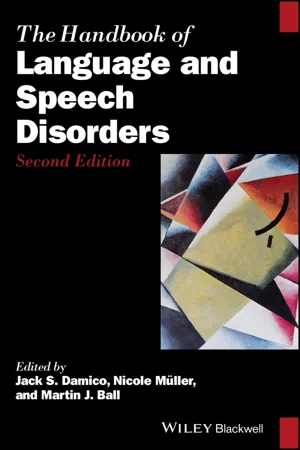Down Syndrome Language
"Down Syndrome Language" refers to the unique speech and language characteristics often observed in individuals with Down syndrome. These characteristics may include delayed language development, speech sound errors, and difficulty with expressive and receptive language skills. Understanding these specific language traits can help in providing appropriate support and intervention for individuals with Down syndrome.
5 Key excerpts on "Down Syndrome Language"
- eBook - ePub
Constraints on Language Acquisition
Studies of Atypical Children
- Helen Tager-Flusberg, Helen Tager-Flusberg(Authors)
- 2014(Publication Date)
- Psychology Press(Publisher)
...Further investigation of this developmental disparity may provide insight regarding both the coherence of syntax and its dependence on general cognitive versus specifically linguistic factors. It might be noted that these two features of atypical language development are not exclusive to individuals with Down syndrome. For example, children with left hemispherectomies and autistic children also fail to acquire full language mastery (e.g., Dennis & Whitaker, 1977; Scarborough, Rescorla, Tager-Flusberg, Fowler, & Sudhalter, 1991). Still more common is a discrepancy between structural aspects of language (syntax and phonology) compared to growth in vocabulary and/or communication skill. Such a discrepancy is, for example, a hallmark of specific language delay (Gathercole & Baddeley, 1989; Rescorla, 1989). Nonetheless, as a window on partial language failure, Down syndrome offers many advantages: 1. Children with Down syndrome are easily and objectively identifiable. The syndrome is comparatively well studied and is uniformly associated with general cognitive deficits, which may vary from mild to severe (for overall reviews see Beeghly, Weiss-Perry, & Cicchetti, 1990; Gibson, 1978; Nadel, 1988; Pueschel, 1988). 2. Full trisomy 21 has consistently been associated with impairments in language structure (Fowler, 1990; Miller, 1987; Wisniewski et al., 1988). 3. Large numbers of children with Down syndrome are currently being raised at home in supportive and hopeful environments. Given what is known about cognitive development in children with Down syndrome, we entertained several hypotheses about how language development might be affected...
- eBook - ePub
- Margaret Walshe, Nick Miller, Margaret Walshe, Nick Miller(Authors)
- 2021(Publication Date)
- Routledge(Publisher)
...Chapter 4 Case report on speech treatment of a young adult with Down syndrome Leslie Mahler DOI: 10.4324/9781003172536-4 Introduction Many neurological disorders of childhood can cause difficulty with speech, language or cognition that interfere with communication effectiveness. A neurological disorder can be present at birth or acquired shortly after birth whilst the child’s nervous system is developing. Down syndrome (DS) is an example of a genetic disorder present at birth caused by an abnormality of chromosome 21. It results in an extra chromosome that interferes with normal growth and development. Down syndrome occurs in approximately 1 in 700 births in the United States (Parker et al., 2010). All children with DS experience cognitive delays, and many have deficits in language and motor speech control. Reduced speech intelligibility caused by dysarthria in people with DS can negatively impact communication effectiveness and social participation because it contributes to communication breakdowns (Kent & Vorperian, 2013). A research study by Jones, Crisp, Kuchibhatla, Mahler, Risoli, Jones, & Kishnani (2019) described the auditory-perceptual speech features of children with DS suggesting that distributed motor speech impairment associated with dysarthria could be addressed with treatment. Speech intelligibility in people with DS can improve between ages 4 and 16 but may still interfere with communication into adulthood (Wild, Vorperian, Kent, Bolt, & Austin, 2018). A case series study of perceptual and acoustic speech characteristics of people with DS included two adults ages 27 and 44 years. The results of those analyses revealed that the most frequently occurring deficits interfering with speech intelligibility were consonant errors, distorted vowels, breathy voice quality and reduced pitch variation (O’Leary, Lee, O’Toole, & Gibbon, 2020)...
- eBook - ePub
All About Language
Science, Theory, and Practice
- Elena Grigorenko, Peggy McCardle, Yury Shtyrov(Authors)
- 2019(Publication Date)
- Brookes Publishing(Publisher)
...We also need to know more about how cognitive strengths and difficulties that accompany individual differences in language profile can exacerbate (or compensate) for these difficulties. The aim of research should ultimately be to develop sustained interventions that prevent an intergenerational downward spiral from language difficulty to social disadvantage and poor mental health. INTRODUCTION Language difficulties are arguably the most pervasive of the childhood disorders. They can be observed in the absence of any obvious genetic, medical, or physical cause (Developmental Language Disorder [DLD]) or in conjunction with another developmental disorder, such as autism spectrum disorder (ASD), Down syndrome, or hearing impairment (Bishop, Snowling, Thompson, Greenhalgh, & Catalise-2 Consortium, 2017). By definition, language disorders impair communication; they also have knock-on effects on educational attainment, social relationships, and, in the absence of appropriate interventions, mental health and well-being. For more than half a century, scientists have sought to understand their nature, etiology, and developmental trajectory. The three state-of-the-art papers in this volume highlight contemporary issues relating to the nature and developmental course of children’s language difficulties. Norbury and Rice report recent research findings on DLD (which include children previously defined as having specific language impairment). There are two important messages—language disorders are stable and persistent, and although there are heritable influences on language acquisition, the outcomes for children with DLD depend on gene–environment interactions...
- eBook - ePub
- Jack S. Damico, Nicole Müller, Martin J. Ball, Jack S. Damico, Nicole Müller, Martin J. Ball(Authors)
- 2021(Publication Date)
- Wiley-Blackwell(Publisher)
...Vesna Stojanovik covers Williams syndrome and Down syndrome in detail, dealing with communication problems encountered by these speakers. She also points forward to the need for neurocognitive investigations of typical development to better understand the impairments found in genetic syndromes. The final chapter in Part I of the book also applies across the field of language and speech disorders. Bonnie Brinton, Martin Fujiki, and Robert Brinton Fujiki discuss the related areas of assessment and intervention in speech‐language pathology. They stress the importance of the social context of communication and the need to bear this in mind in both assessment and intervention. The chapter provides step‐by‐step advice on how to undertake these two aspects of the speech‐language pathologist’s practice, whatever communication problem is involved. Part II of the Handbook contains eight chapters dealing with different language disorders. In disordered language, various linguistic features can be disturbed, ranging from lexical items (e.g., word‐finding difficulties), through morphology and syntax (missing or incorrect affixes, sentence ordering difficulties) to semantics and pragmatics (inaccurate assigning of meaning to words, inappropriate use of language for a specific context). The chapters in this part of the book highlight which of these features are most important in the specific disorder under discussion, but they are not limited to this. For example, Patricia Prelock, in her chapter on autism, describes the linguistic markers of this disorder, but also discusses at length the recent changes to the classification of autism and highlights the importance of appropriate assessment and intervention. Paul Fletcher in Chapter 8 outlines the typical trajectories of language acquisition, highlighting the wide variation in this process between individuals encompassing both vocabulary and grammar...
- eBook - ePub
- Dani Byrd, Toben H. Mintz(Authors)
- 2011(Publication Date)
- Wiley-Blackwell(Publisher)
...Chapter 11 Language, Speech, and Hearing Disorders Entire fields of medical study are devoted to the wide variety of disorders that relate to the human ability to communicate. These disorders can range from problems with hearing to difficulties with vocal fold vibration to atypicalities of the brain that impact the ability to produce or process speech and/or language. In the last chapter, we discussed aphasia as an example of a communication disorder that arises from the central nervous system. In this chapter, we introduce how language development, speech, and hearing can be atypical in complex ways that we are only beginning to understand. While this chapter confines itself to a handful of specific disorders of language, speech, and hearing, there are of course many disorders that affect communication more globally as part of neurologically complex syndromes. Such disorders – such as autism spectrum disorder, Down syndrome, fragile X syndrome, and Williams syndrome – are broad in nature, with language communication being only one component. There are many good resources for learning more about these disorders, some of which are listed at the end of this chapter. Specific Language Impairment In Chapter 1 we discussed how all healthy children go naturally through a developmental process of learning language. The question arises, however, as to what subtle disorders in the genetic makeup and/or early experience of an individual can give rise to language impairment. Of course, atypicalities in the speech motor system or in the hearing system will likely make speech and language perception atypical. But what about disorders in language ability per se that are innate rather than acquired like the aphasia we discussed in the last chapter? Such disorders do exist. One of them is specific language impairment (SLI)...




